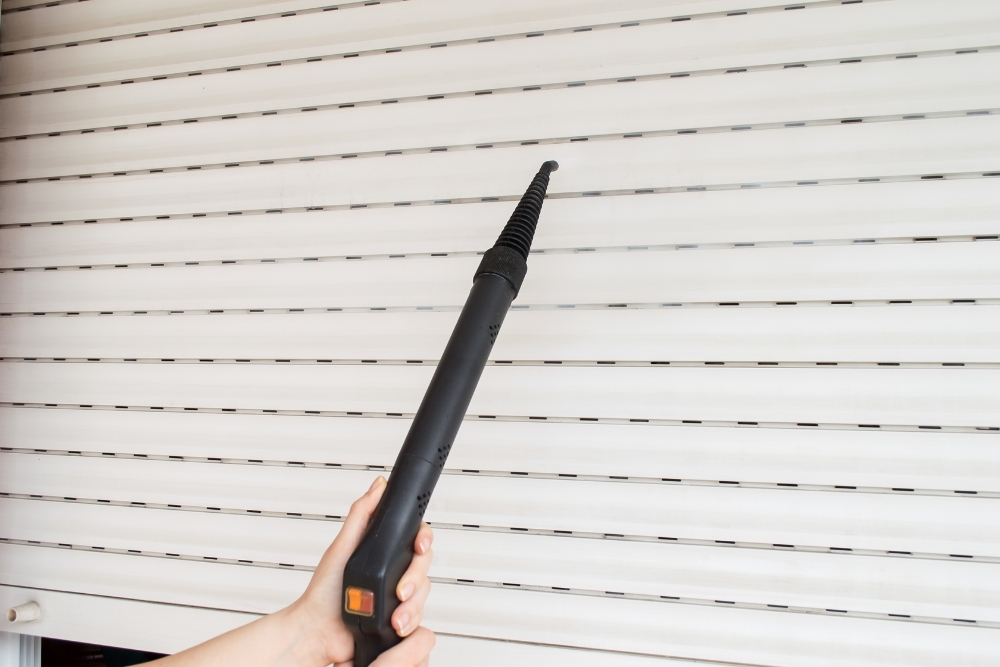Roller shutters are a popular and practical choice for both residential and commercial properties, providing security, insulation, and aesthetic appeal. However, like any aspect of your property, they require regular care to maintain their functionality and appearance.
In this practical guide to cleaning your roller shutters, we’ll cover the importance of keeping them clean while providing simple steps for getting the job done right at home.
Key Takeaways
- Regularly cleaning your roller shutters helps prevent damage and wear and tear, keeps them looking new, and improves overall security by ensuring they function properly.
- The essential tools needed for cleaning roller shutters include a soft-bristled brush, non-abrasive cleaner like mild detergent mixed with warm water or microfiber cloth. Water is also necessary for rinsing off the detergents used during the cleaning process to avoid leaving streaks on the surface of the shutters.
- Inspecting roller shutters before cleaning is crucial in identifying any signs of damage such as rusted metal or loose screws that need fixing. Using gentle tools like soft-bristled brushes prevents further harm when wiping down roll-up blinds and aids in removing abrasive pollutants between its guides effectively.
- A practical guide to keeping your Roller Shutters clean without hassle can be achieved by following these tips. With regular maintenance, inspections for damages early on alongside lubrication of moving parts, even daily use cannot reduce their operating lifespan significantly.
Why Cleaning Your Roller Shutters Is Important
Regularly cleaning your roller shutters helps prevent damage and wear and tear, keeps them looking new, and improves overall security by ensuring they function properly.
Prevents Damage and Wear And Tear
Regular cleaning of roller shutters helps prevent damage and wear and tear, ensuring their longevity and optimal performance. Dirt, grime, and pollutants can accumulate on the shutter’s surface over time, leading to corrosion or jamming of the moving parts.
For example, excessive dust build-up may cause the shutters to fail in closing properly or make them difficult to operate.
In addition to preserving functionality, regular cleaning also protects the aesthetics of your roller shutters. Harsh weather conditions and external factors can contribute to fading colors or peeling paint.
Keeps Your Shutters Looking New
Regularly cleaning your roller shutters can help keep them looking new for years to come. Over time, build-up of dirt, grime, and pollutants can cause discoloration and wear on the material.
Not only does regular cleaning prevent wear and tear from setting in prematurely, but it also helps maintain the overall aesthetic of your home or business. Dirty roller shutters can significantly decrease curb appeal and negatively impact first impressions, especially if they are visible from the street or main entrance.
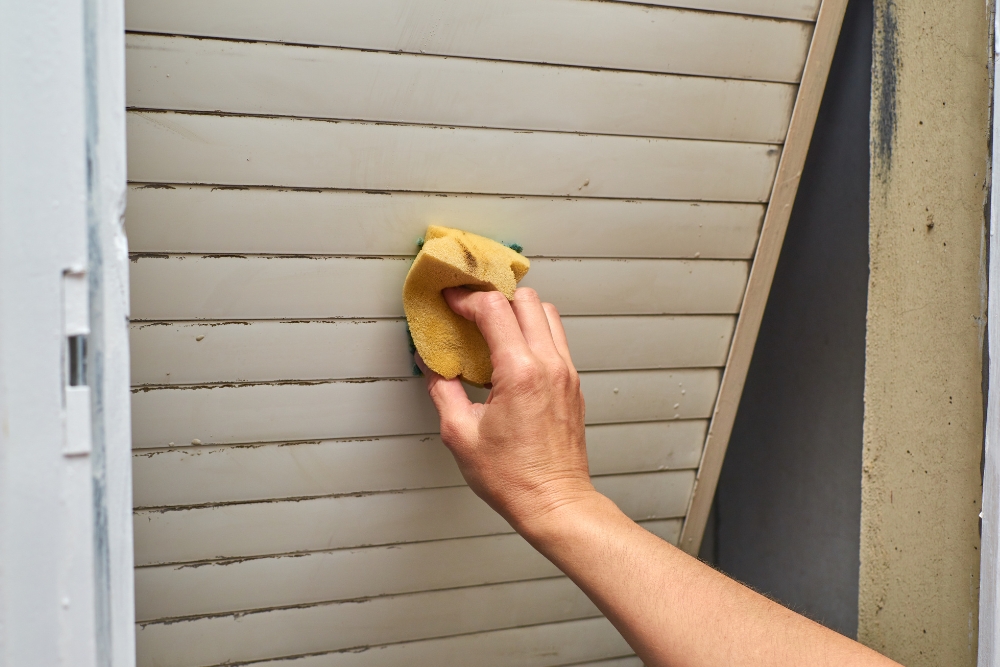
Improves Overall Security
Cleaning your roller shutters is not just about keeping them looking new and preventing damage, but it also improves overall security. Dirt and debris that buildup between the slats or in the guides can affect their ability to close correctly or even jam.
A regularly maintained shutter system will provide better protection against break-ins and weather conditions. In addition, clean shutters give burglars less coverage to hide behind when attempting a break-in or vandalising your property.
Regularly inspecting and maintaining the parts of the shutter system that are responsible for locking it in place, such as tracks latches, screws or bolts helps keep intruders out while ensuring long-lasting performance from these crucial components.
Ensure that they are always fastened securely after each cleaning session so that burglars cannot pry open one side easily with enough force applied at either end.
Tools And Materials Needed for Cleaning
To effectively clean your roller shutters, you will need a soft-bristled brush, non-abrasive cleaner, microfiber cloth, water, and a pressure washer (optional).
Soft-Bristled Brush
One of the essential tools needed for cleaning roller shutters is a soft-bristled brush. A soft-bristled brush is gentle enough to avoid causing damage but still effective in removing dirt, dust, and grime that accumulate on the shutters.
It can be used to clean both the interior and exterior surfaces of the shutters effectively. For instance, when cleaning the guides between the slats, one can use a soft-bristled brush to scrub off any stubborn stains or pollutants that may have accumulated over time.
Regular maintenance and cleaning with a soft-bristled brush help prevent corrosion and wear-and-tear on your roller shutters while extending their lifespan significantly.
Neglecting routine cleaning could result in costly repairs or replacements due to irreversible damages caused by excessive dirt build-up over time.
Non-Abrasive Cleaner
When it comes to maintaining roller shutters, using a non-abrasive cleaner is crucial. Abrasive cleaning solutions or materials can scratch and damage the surface of the shutters, leading to wear and tear over time.
One excellent example of a non-abrasive cleaner for roller shutters is mild detergent like dishwashing liquid mixed with warm water. This solution helps break down stubborn stains without damaging the material of the shutters.
Another option is a magnetic roller shutter cleaner that uses microfiber cloths to attract and remove dirt from both sides of the shutter slats at once.
Microfiber Cloth
A microfiber cloth is a crucial tool in cleaning roller shutters. It has a finely woven texture that effectively picks up dirt, grime, and dust particles without leaving any streaks or scratches on the surface.
Using a microfiber cloth for cleaning also ensures that there are no residues left behind after wiping down the shutters. These cloths are perfect for removing fingerprints and other stubborn stains from the outside of your roller shutters gently.
They can be washed and reused multiple times, making them an eco-friendly option compared to disposable wipes or paper towels.
Water
Water is a crucial component when it comes to cleaning your roller shutters. It’s important to use clean water both during and after the cleaning process, as any leftover soap or detergent can leave streaks on your shutters.
A microfiber cloth is ideal for drying off the rollers after rinsing with clean water.
In addition, hard water may contain minerals that can leave spots on your roller shutters, so it’s advisable to use filtered or distilled water when possible. Avoid using hot water as it may warp or damage the components of the shutter.
Pressure Washer (Optional)
For those who prefer a more efficient and thorough cleaning method, a pressure washer can be used to clean both the interior and exterior of roller shutters. However, caution must be exercised as using too much pressure may cause damage to the shutters.
It is recommended to start with low-pressure settings before gradually increasing it until the desired level of cleanliness is achieved.
Using a pressure washer can save time and effort when cleaning stubborn stains or contaminants on roller shutters, but it’s important to remember that this tool should only be used sparingly and with care.
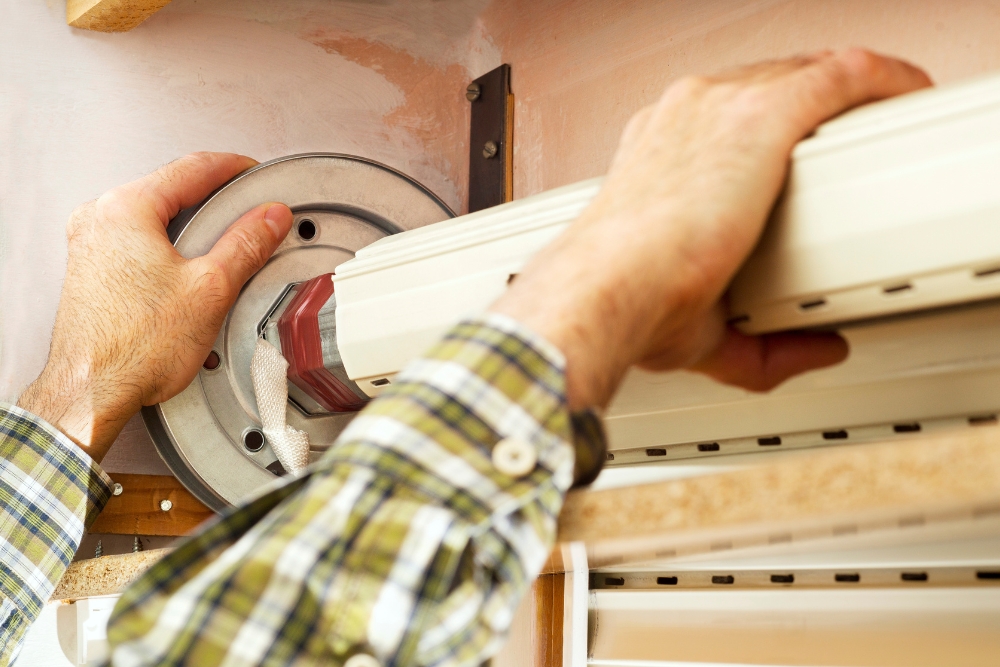
How To Clean Your Roller Shutters – Inside
Inspect the shutters for any damage or wear and tear before proceeding with cleaning, then use warm, soapy water to clean the interior in an up and downward direction to prevent misalignment.
Inspect Shutters For Damage
Before cleaning your roller shutters, it is crucial to inspect them for any damage. Check the slats, guides, and other components for cracks or dents that can affect their operation.
Regular inspections can help identify issues early on before they become more significant problems that require costly repairs or replacement. If you notice any signs of damage such as rusted metal or loose screws, it’s best to address them right away.
By keeping your roller shutters in top shape through regular maintenance and inspection, you’ll ensure that they continue providing reliable protection and security for years to come.
Use Warm, Soapy Water to Clean The Interior
Cleaning the interior of your roller shutters is an essential part of their maintenance to keep them functioning correctly and looking new. You want to begin by inspecting the shutters for damage before starting cleaning to prevent any further harm.
Once you have done this, warm, soapy water can be used to clean the interior effectively. Using a soft cloth or sponge, wipe down each slat from top to bottom with some pressure applied.
Additionally, wiping down the shutters’ guides using a soft-bristled brush will remove any abrasive grime and pollutants that may have accumulated between them over time.
When finished, rinse off all excess soap with clean water and dry thoroughly using a microfiber cloth or allow them to air-dry if possible.
Clean In an Up and Downward Direction to Prevent Misalignment
When cleaning the interior of your roller shutters, it is important to clean in an up and downward direction to prevent misalignment. This means that you should avoid cleaning across the slats as this may cause them to twist or warp, making it difficult for the shutters to close properly.
In addition, using a soft-bristled brush can help remove any dirt or debris that has accumulated between the slats without causing damage. Cleaning with too much force could potentially scratch or dent the shutters; therefore, using gentle pressure while going along with an up-down pattern will result in better results.
Use A Soft-Bristled Brush to Clean The Guides
It’s essential to keep the guides of your roller shutters clean to ensure their functionality. When cleaning, use a soft-bristled brush to avoid damaging the surfaces. Dirt and grime can accumulate on the guides over time, which may cause them to stick or prevent smooth operation.
Regularly inspecting and cleaning the guides between the slats is necessary for preventing damage caused by excessive dust and dirt buildup. Wiping down these areas with a cloth or sponge removes abrasive grime and pollutants that accumulate between each slat.
This prevents friction from developing, leading to misalignment or malfunctioning of your roller shutters over time.
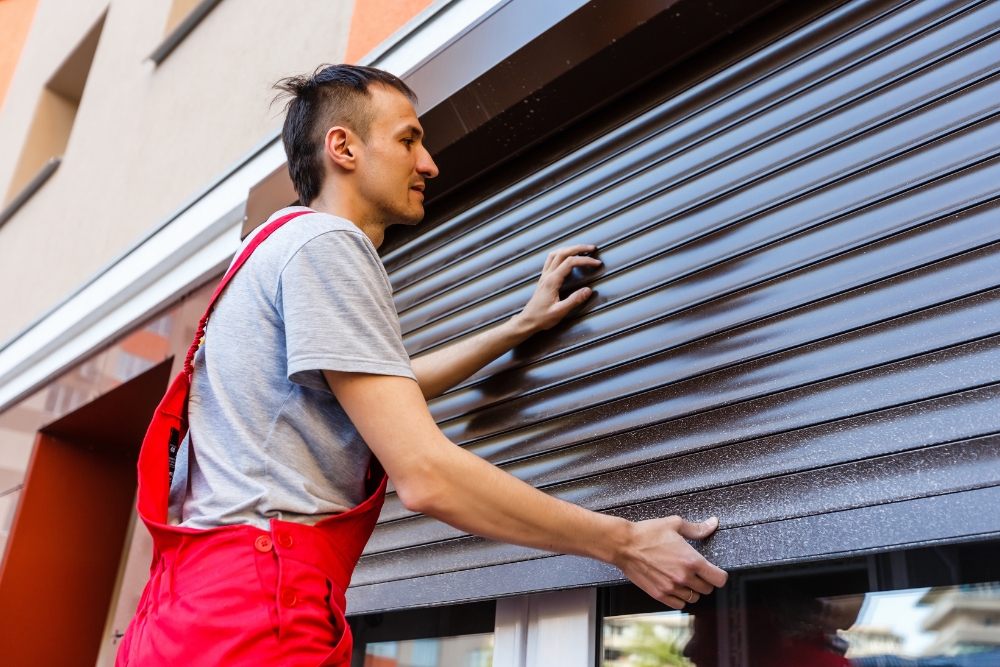
Wipe Down with Clean Water And Dry
Once you have cleaned the interior and exterior of your roller shutters thoroughly, it is essential to wipe them down with clean water and dry them. Wiping the shutters down with clean water can remove any leftover residue or cleaning solution that may impact their functionality over time.
Leaving the shutters wet after cleaning could also lead to dirt accumulation on the surface, which can cause corrosion or other damage over time.
Drying your roller shutters is equally important as leaving them moist can create a welcoming environment for mold growth, rusting, or other forms of deterioration. Using a microfiber cloth or an absorbent towel is best for drying roller shutters as they are gentle on surfaces and don’t leave behind streaks or lint.
How To Clean Your Roller Shutters – Outside
To clean the exterior of your roller shutters, begin by rinsing away dirt and debris using a hose or pressure washer.
Inspect Shutters For Damage
Before cleaning your roller shutters, it’s important to inspect them for any damage or wear and tear. This can include dents, scratches, rust, or broken slats that need repairing.
Regular inspections can help prevent more significant problems down the line and keep your roller shutters in good condition longer. The buildup of dust and debris between the slats can also create friction that causes jamming or failure to close properly over time.
Use A Hose To Rinse Away Dirt And Debris
Once you have inspected the exterior of your roller shutters for any damage, it’s time to start cleaning them. Begin by using a hose with moderate water pressure to rinse away any dirt and debris that has accumulated on the surface.
It’s crucial not to use high-pressure water as this can cause harm or damage the shutters. After rinsing away most of the dirt and debris, proceed with scrubbing using a soft-bristled brush and mild detergent, if necessary, then rinse again till all traces of soap are washed off.
Use A Soft-Bristled Brush and Detergent To Scrub Away Stubborn Stains
When it comes to cleaning the exterior of your roller shutters, stubborn stains that have accumulated over time can be quite challenging to remove. However, with a soft-bristled brush and mild detergent, you can effectively scrub away these unsightly stains without damaging the shutters.
It’s essential to avoid harsh chemicals or abrasive materials when cleaning roller shutters as they could damage their surface. For persistent stains such as grease or oil marks, a magnetic roller shutter cleaner or specialised cleaning kit may come in handy.
Rinse With Clean Water And Dry
After scrubbing away any stubborn stains or dirt on both the inside and outside of your roller shutters, make sure to rinse the surfaces thoroughly with clean water. This is especially important for outdoor cleaning, as remaining soap residue could attract dust and grime back to the shutter surface.
Regularly rinsing and drying your roller shutters will not only keep them looking clean but also help prolong their lifespan by preventing corrosion caused by moisture build-up.
It’s essential to ensure that all parts of the shutter are dried properly, including the guides and between slats of outdoor shutters where water can easily accumulate.
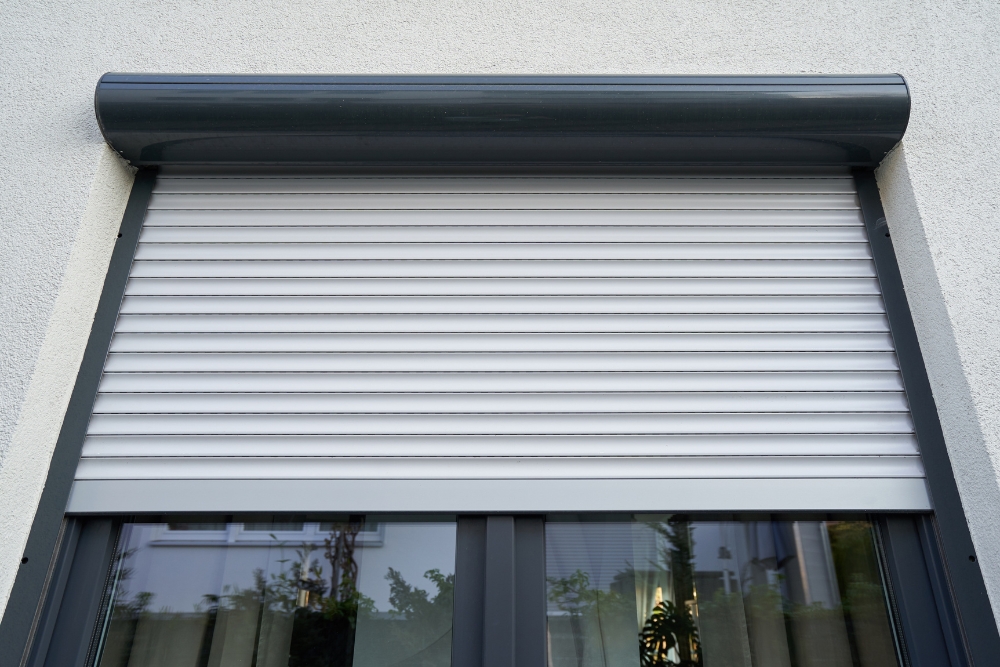
Tips For Maintaining Your Roller Shutters
To keep your roller shutters in good condition, it’s important to establish a regular cleaning schedule, inspect for wear and tear, lubricate moving parts, and avoid abrasive chemicals – read on to learn more!
Regular Cleaning Schedule
To ensure that your roller shutters remain in top condition, it’s essential to implement a regular cleaning schedule. This will help prevent any dirt and debris build-up that may lead to mechanical problems or cosmetic damage.
For instance, if you live near a busy road where there’s lots of dust and pollution, it is recommended to clean the exterior shutters every week. In contrast, interior shutters in low-traffic areas may only require cleaning once per month.
By performing routine maintenance on your roller shutters such as wiping away dust from the slats and guides regularly, lubricating movable parts when necessary using appropriate substances like silicon spray or WD40; you can keep them running smoothly for years without calling for professional services.
Inspect For Damage and Wear
Regular inspection of your roller shutters for damages and wear is essential to ensure their optimal functionality. Small cracks or deformations in the slats or guides can cause jams, reduce security, and shorten the lifespan of your shutters if left unattended.
Therefore, it’s critical to inspect them regularly for signs of damage such as dents, rusts, broken locks, scratches, or discoloration. Some useful tips to help you with this task include checking the slats’ alignment and ensuring they’re properly seated in their guides.
Moreover, taking care of minor repairs promptly will save you time and money in the long run by preventing significant damages that may require professional repairing services.
Lubricate Moving Parts
To ensure your roller shutters continue to operate smoothly, it is important to lubricate the moving parts regularly. This includes oiling the rollers and hinges, as well as spraying a silicone lubricant on any metal tracks or guides.
Regular maintenance of these moving parts not only helps extend the lifespan of your roller shutters but also reduces noise during operation and improves overall functionality.
It is recommended that this task be completed at least once a year or more frequently if you notice any squeaking or stiffness in the shutter’s movement. A simple lubrication kit can be purchased from most hardware stores for easy DIY application.
Avoid Harsh Chemicals and Abrasive Materials
Harsh chemicals and abrasive materials should be avoided when cleaning your roller shutters. Such substances can damage the surface of the shutter and cause discoloration, scratches, or even corrosion over time.
Using harsh chemicals can also pose risks to your health due to toxic fumes that may arise during the cleaning process. Furthermore, using abrasive materials such as steel wool can scratch the surface of your shutters, which is something you want to avoid at all costs.
Conclusion
With the above practical guide, cleaning your roller shutters couldn’t be easier. Regularly maintaining and cleaning them will keep them looking new and working correctly for years to come.
Remember to use non-abrasive cleaners, soft-bristled brushes, and microfiber cloths when cleaning your shutters. Inspect for damage often and lubricate moving parts for smooth operation.
General Facts
1. Cleaning the inside of roller shutters should be done in an up and downward direction to avoid misalignment.
2. Warm, soapy water can be used to clean the interior of roller shutters effectively.
3. It is essential to clean and maintain roller shutters regularly to ensure their functionality.
4. A soft cloth or sponge, a soft-bristled brush, and mild detergent like dishwashing liquid are sufficient for cleaning roller shutters.
5. Wiping down the shutters can remove abrasive grime and pollutants that accumulate on the guides and between the slats.
6. Closing the shutters before cleaning is recommended.
7. Dust and debris should be wiped away from the roller shutters before proceeding with cleaning.
8. Cleaning the guides between the shutters can be done using a soft-bristled brush.
9. Roller shutters can get jammed or fail to close properly due to excessive dust and dirt build-up.
10. Cleaning roller shutters is a quick and easy process that can be done with a soft cloth and a brush with soft bristles.

